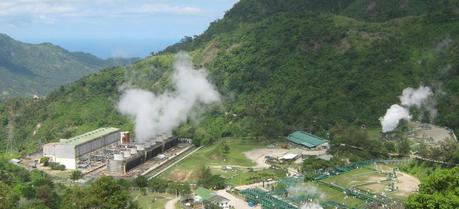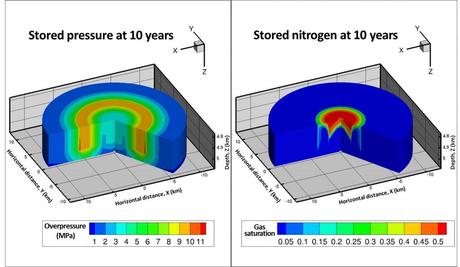 The Palinpinon geothermal power plant in Negros Oriental, Philippines. (Credit: Mike Gonzalez http://commons.wikimedia.org/wiki/User:TheCoffee)
The Palinpinon geothermal power plant in Negros Oriental, Philippines. (Credit: Mike Gonzalez http://commons.wikimedia.org/wiki/User:TheCoffee)
Researchers are developing a new geothermal plant design that will lock away unwanted carbon dioxide (CO2) underground and use it as a tool to boost electric power generation by at least 10 times compared to conventional geothermal power.
The technology for this geothermal plant design already exists in different industries, and the researchers, led by Tom Buscheck, earth scientist from Lawrence Livermore National Laboratory (LLNL), are hopeful that their new approach to the technology will expand the use of geothermal energy in the U.S. far beyond the small handful of states that can take advantage of it now. Heat Mining Company, LLC, a startup spun off from the University of Minnesota, expects to have an operational project based on an earlier form of this new approach in 2016.
The new geothermal plant design resembles a cross between a geothermal power plant and the Large Hadron Collider: it features a network of subsurface concentric rings of horizontal wells inside which CO2, nitrogen and water circulate to draw heat from deep below ground up to the surface, where it can be used to turn turbines and generate electricity.
“This well arrangement encircles the injected fluids with a subsurface hydraulic dam, functioning much like a hydroelectric dam. The intent is to recover the maximum energy benefit from fluid injection operations, a major improvement over conventional geothermal power systems,” Buscheck noted.
The design contrasts with conventional geothermal plants in a number of important ways, explained study co-principal investigator Jeffrey Bielicki, assistant professor of energy policy in the Department of Civil, Environmental and Geodetic Engineering at The Ohio State University.
“Typical geothermal power plants tap into hot water that is deep underground, pull the heat off the hot water, use that heat to generate electricity and then return the cooler water back to the deep subsurface. Here the water is partly replaced with CO2 and/or another fluid,” he said.
“There are benefits to using CO2, because it mines heat from the subsurface more efficiently than water,” he continued. “This combined approach (originally developed by Martin Saar at the University of Minnesota) can be at least twice as efficient as conventional geothermal approaches, and expand the reach of geothermal energy in the United States to include most states west of the Mississippi River.”
The research team used computer simulations to design the system. In the simulations, a system of four concentric rings of horizontal wells about three miles below ground, with the outer ring being a little more than 10 miles in diameter, produced as much as a half a gigawatt of electrical power—an amount comparable to a medium-sized coal-fired power plant, and more than 10 times bigger than the 38 megawatts produced by the average geothermal plant in the U.S.

The distribution of stored pressure and nitrogen in the underground geothermal reservoir system is shown after 10 years of energy storage and production operations. (Credit: Lawrence Livermore National Laboratory). Click to enlarge.
The simulations also revealed that a plant of this design might sequester as much as 15 million tons of CO2 per year, which is roughly equivalent to the amount produced by three medium-sized coal-fired power plants in that time.
“One of our key objectives when we began developing the CO2 plume geothermal technology was to find a way to help make CO2 storage cost effective while expanding the use of geothermal energy,” said Jimmy Randolph, postdoctoral researcher in the Department of Earth Sciences at the University of Minnesota.
During the past year, Buscheck added another gas—nitrogen—to the mix, resulting in a design that he and his colleagues believe will enable highly efficient energy storage at an unprecedented magnitude (at least hundreds of gigawatt hours) and unprecedented duration (days to months), provide operational flexibility, and lower the cost of renewable power generation.
“Nitrogen has several advantages,” Buscheck explained. “It can be separated from air at lower cost than captured CO2, it’s plentiful, it’s not corrosive and will not react with the geologic formation in which it is being injected. And because nitrogen is readily available, it can be injected selectively. Thus, much of the energy required to drive the hot fluids out of the deep subsurface to surface power plants can be shifted in time to coincide with minimum power demand or when there is a surplus of renewable power on the electricity grid.”
“Because we are storing energy in the form of pressurized fluids, we can further improve on this concept by selectively producing hot fluids when power demand is high, as well as reduce or stop that production when power demand is low. What makes this concept transformational is that we can deliver renewable energy to customers when it is needed, rather than when the wind happens to be blowing, or when spring thaw causes the greatest runoff.”
The new geothermal plant design is so efficient at extracting heat that even smaller-scale “hotspots” throughout the western U.S. could generate power. The geothermal plant, however, would probably have to be connected to a large CO2 source, such as a coal-fired power plant, which was scrubbing the CO2 from its own emissions. That connection would likely be made by pipeline. Buscheck added that a pilot plant based on this design could initially be powered solely by nitrogen injection, in order to prove the economic viability of using CO2. The study also showed that this design can work effectively with or without CO2, broadening where this approach could be deployed. The research team is currently working on more detailed computer model simulations and economic analyses for specific geologic settings in the U.S.
Elliot, T. R., Buscheck, T. A., Celia, M. (2013). Active CO2 reservoir management for sustainable geothermal energy extraction and reduced leakage Greenhouse Gases: Science and Technology, 3 (1), 50-65 DOI: 10.1002/ghg.1328
